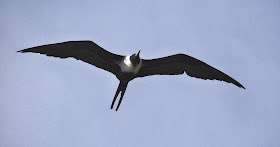 |
| Red-tailed Tropicbird |
Apart from the impressive populations and variety of terns on Lady Elliot Island (next post -
see here) there are plenty of other avian attractions, chief among them the Red-tailed Tropicbird. Two pairs of tropicbirds were nesting during our stay - one at the end of the airstrip and one in front of a tourist cabin. Both nests contained a single well-fledged youngster. Like most other island birds, the tropicbirds were unconcerned by the presence of humans.
 |
| Red-tailed Tropicbird |
 |
| Great Frigatebird - male |
Frigatebirds were frequently seen flying about the island, although none were spotted landing or roosting during our stay. A good proportion of birds were young, presenting identification challenges at times, but I estimated that 70-80 per cent of the 100-120 frigatebirds I saw over five days were Great Frigatebirds. The remainder were Lesser Frigatebirds; often the two species were in the air together. Small numbers of Brown Booby were among other seabirds seen offshore.
 |
Great Frigatebird - female
|
 |
| Lesser Frigatebird - female |
 |
| Buff-banded Rail |
Buff-banded Rails were extremely common on the island, with 200-300 birds present. They could be a nuisance at the dinner table, being quick to raid an unattended plate. The rails are secretive in their well-vegetated habitat on the mainland but on the island they are fearless and forage openly, even at night.
 |
| Buff-banded Rail |
 |
| Eastern Reef-Egret |
Eastern Reef-Egrets were fairly common; about 70 per cent were white phase, the remainder grey phase.
 |
| Lesser Sand-Plover |
About 10 Lesser Sand-Plovers were on the island.
 |
| Pied Oystercatcher |
One pair each of Pied Oystercatcher and Sooty Oystercatcher was present, sharing similar habitat. Note the large eye-ring of the northern race of Sooty Oystercatcher
opthalmicus here.
 |
| Sooty Oystercatcher |
 |
| Grey-tailed Tattler |
Both species of tattler were in good numbers and it was interesting to see them sharing similar habitat (like the oystercatchers). A total of 22 Grey-tailed Tattlers and 9 Wandering Tattlers were counted. Sometimes they roosted loosely together at high tide on the reefs.
 |
| Wandering Tattler |
I was surprised to find a Wandering Tattler in breeding plumage roosting in a tree.
 |
| Wandering Tattler |
 |
| Pacific Golden Plover & Ruddy Turnstone |
Good numbers of Ruddy Turnstone and Pacific Golden Plover were on the island along with a few Red-necked Stints.
 |
| Red-necked Stint |
 |
| Sanderling |
An unexpected find was a Sanderling which fed on the airstrip or along an adjacent beach, sometimes keeping company with the stints.
 |
| Wedge-tailed Shearwater |
Wedge-tailed Shearwaters were nesting commonly about the resort, including a pair behind our cabin. They flew in after dusk and were quite vocal throughout the evening, which is why the resort supplies free earplugs to guests. I also found several beachwashed Short-tailed Shearwaters on the island - they would not normally be expected here but it was not surprising given the extent of the huge wreck of this species being experienced this spring throughout south-eastern Australia.
 |
| Wedge-tailed Shearwater |
 |
| Silvereye |
A few Silvereyes of the distinctive Great Barrier Reef race
chlorocephala were about, though not as commonly as I expected. Other land birds included a couple of Tawny Grassbirds, several Sacred Kingfishers and Channel-billed Cuckoo heard. The only raptor seen was a single White-bellied Sea-Eagle.
 |
| Lady Elliot Island Resort |
A general shot of the resort (above) and the island's historic lighthouse. The service and food at the resort was excellent and this ecotourism destination can be highly recommended. A separate post will follow on turtles and fish seen.






















Definitely worth a visit!
ReplyDeleteGreat pictures again, Greg. I really appreciate the chance to see similar species like the Tattlers and Frigatebirds side by side. Strange that with such an abundance of easy prey, there'd be so few predators around - besides the Sea Eagle, would there be any rats or snakes on the island? Looking forward to the next post!
ReplyDeleteA belated reply Christian. No rats or snakes. Presumably the rails do most of the predating of chicks and eggs
DeleteWow, what a place! I can't believe how adventurous some BBrails become compared to mainland experiences! Thanks for sharing!
ReplyDelete